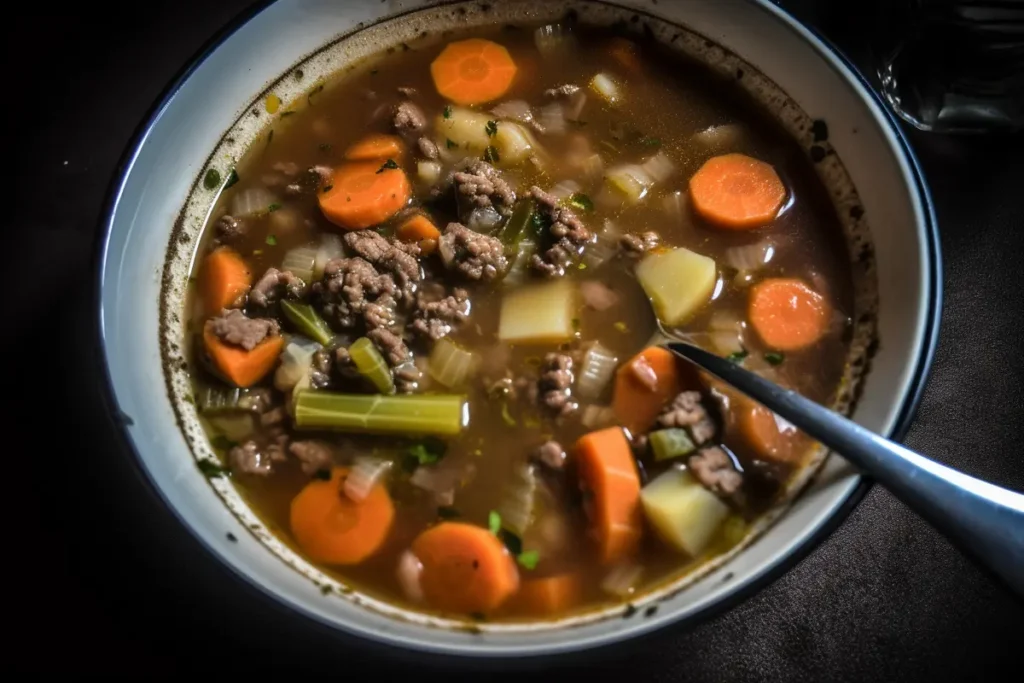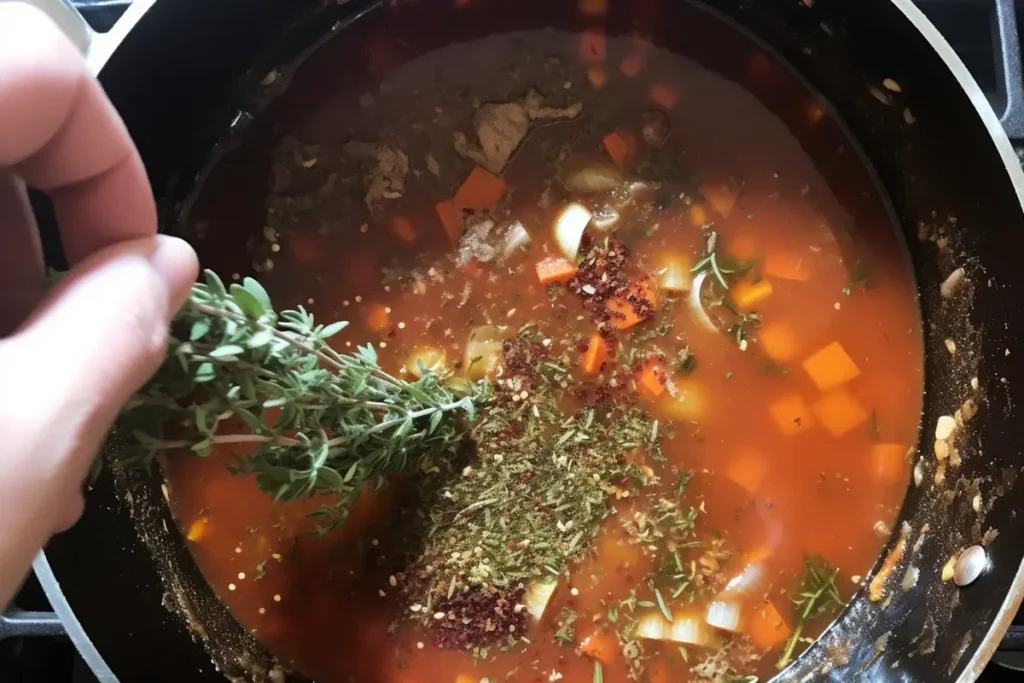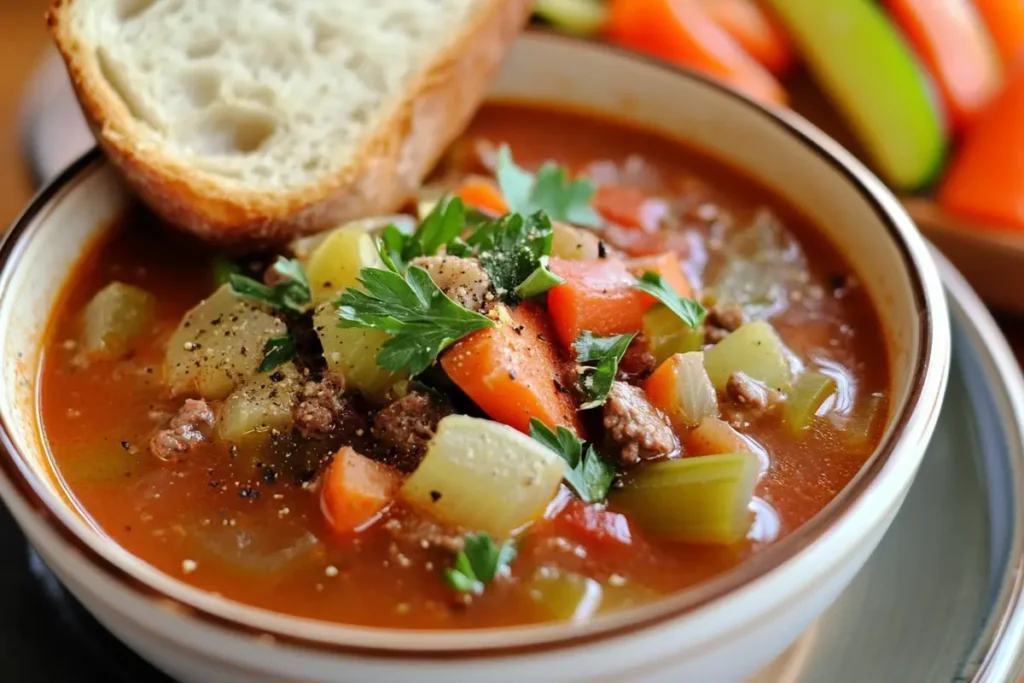Vegetable beef soup is a comforting classic, packed with hearty beef, vibrant vegetables, and aromatic broth. But sometimes, it can fall flat, leaving you with a bland and uninspiring dish. Don’t worry—this is fixable! With a few adjustments, you can transform a tasteless soup into a rich and satisfying bowl of flavor. From seasoning tips to cooking techniques and ingredient tweaks, this guide will show you exactly how to fix bland vegetable beef soup.
Table of Contents
Understanding the Challenge of Bland Vegetable Beef Soup
Why Does Vegetable Beef Soup Turn Out Bland?
The most common reason vegetable beef soup tastes bland is a lack of flavor layering. When ingredients aren’t seasoned properly or cooked to their fullest potential, the dish can taste one-dimensional. A good soup relies on the balance of aromatics, umami-rich components, herbs, and the perfect broth. Without these, it may lack the boldness you’re craving.
The Importance of Flavor Balance in Soups
A well-balanced soup doesn’t overwhelm with salt or spice but instead offers a medley of tastes: savory, sweet, acidic, and sometimes even a hint of bitterness. For vegetable beef soup, it’s vital to balance the richness of beef with the natural sweetness of vegetables and the brightness of herbs or citrus.
Common Pitfalls That Lead to Blandness
- Skipping Seasoning Early: If you’re only salting at the end, the flavors won’t have enough time to meld.
- Using Low-Quality Broth: A weak, watery base won’t provide the richness your soup needs.
- Overcooking Vegetables: When vegetables lose their texture and flavor, they contribute little to the dish.
- Forgetting Umami Ingredients: Umami-rich elements, like tomatoes or Worcestershire sauce, are essential for depth.
How to Fix Bland Vegetable Beef Soup: Common Causes of Blandness

Inadequate Seasoning
One of the primary reasons soups taste bland is a lack of proper seasoning. Salt is not just an addition; it’s the foundation that helps bring out the natural flavors of the beef and vegetables. Many home cooks underestimate how much salt is required for a large pot of soup or rely on table salt, which doesn’t always dissolve evenly.
Beyond salt, other seasonings, such as freshly cracked black pepper, paprika, and garlic powder, add layers of complexity. Skipping these can leave your soup tasting flat. Seasoning as you go, instead of all at once at the end, ensures that every ingredient contributes to the overall flavor.
Overcooking or Undercooking Ingredients
Timing is everything when cooking soups. Overcooked vegetables lose their flavor, becoming mushy and dull. On the other hand, undercooked ingredients, particularly tough cuts of beef, can be chewy and fail to infuse the broth with their savory richness.
To fix this, stagger when you add ingredients to the pot. For example, harder vegetables like carrots and potatoes should go in first, while more delicate ones, such as zucchini, should be added toward the end. This technique ensures that every element is cooked to perfection and retains its natural taste.
Insufficient Use of Aromatics
Aromatics are the backbone of any great soup, and skipping them can result in blandness. Ingredients like onions, garlic, celery, and carrots not only build the base flavor but also create a depth that sets the stage for the rest of the soup.
If these aren’t sautéed beforehand, they won’t release their natural sugars and aromas, leaving your soup with an unbalanced flavor. Make sure to take the time to cook your aromatics in a bit of oil or butter until fragrant and slightly caramelized before adding any liquid.
Lack of Umami-Rich Components
Umami, the savory “fifth taste,” is what makes soups feel hearty and satisfying. Without umami-rich components, your vegetable beef soup can taste watery or lack depth. Ingredients such as tomato paste, soy sauce, or Worcestershire sauce can elevate the flavor instantly.
For even more umami, consider adding mushrooms, parmesan rinds, or even a splash of fish sauce (in moderation). These elements don’t necessarily change the soup’s overall flavor but enhance its savory undertones, making every bite more robust.
Enhancing Flavor: How to Fix Bland Vegetable Beef Soup

Proper Seasoning Techniques
The Role of Salt in Flavor Enhancement
Salt isn’t just an ingredient; it’s a flavor amplifier. Without enough salt, even the best ingredients can taste flat. Instead of adding all the salt at once, sprinkle small amounts throughout the cooking process. This allows the salt to penetrate each layer of the soup, bringing out the natural sweetness of vegetables and the savory depth of the beef. Sea salt or kosher salt works particularly well due to its clean taste and ease of dissolving.
Utilizing Freshly Ground Black Pepper
Black pepper adds a subtle, earthy heat that complements the heartiness of vegetable beef soup. Freshly ground pepper is far superior to pre-ground varieties because it releases essential oils that add both aroma and flavor. A few twists of the pepper grinder at the beginning and end of cooking can make all the difference, giving your soup a warm, peppery finish.
Incorporating Acidic Elements
Adding Vinegar or Citrus Juice
A splash of acidity can brighten the flavors in your soup, balancing out the richness of the beef and the sweetness of the vegetables. A dash of vinegar (like apple cider or white vinegar) or a squeeze of lemon juice at the end of cooking can elevate the overall taste. Add it sparingly, though—just enough to perk up the flavors without overpowering them.
Benefits of Tomato Paste or Diced Tomatoes
Tomatoes bring both acidity and umami to the table. A tablespoon of tomato paste adds a concentrated depth, while diced tomatoes provide a tangy sweetness. For best results, sauté the tomato paste with your aromatics before adding liquid, which caramelizes its sugars and deepens its flavor.
Utilizing Umami Boosters
Incorporating Worcestershire Sauce
Worcestershire sauce is an umami powerhouse, thanks to its combination of fermented ingredients. A teaspoon or two can give your soup an instant flavor lift, adding a savory complexity that pairs beautifully with beef and vegetables.
Adding Soy Sauce or Miso Paste
Soy sauce and miso paste are versatile umami boosters. While soy sauce adds a salty, earthy note, miso paste contributes a nutty, slightly sweet flavor. Stirring in a small amount of either ingredient toward the end of cooking enhances the broth’s depth without overpowering the other flavors.
Using Parmesan Rinds or Cheese
Adding a Parmesan rind while the soup simmers is a simple trick to infuse the broth with a creamy, nutty flavor. If you don’t have a rind, grating a small amount of Parmesan cheese over the finished soup achieves a similar effect, giving it a comforting, savory touch.
Enhancing with Aromatics and Herbs
Sautéing Onions, Garlic, and Celery
Aromatics like onions, garlic, and celery form the flavorful base of your soup. Sautéing them in oil or butter before adding the liquid allows them to release their natural sweetness and aromas. This simple step creates a solid foundation for the rest of your ingredients to shine.
Incorporating Fresh Herbs: Thyme, Rosemary, and Parsley
Fresh herbs add brightness and depth to soups. Sprigs of thyme and rosemary lend an earthy, woodsy flavor, while chopped parsley brings a pop of freshness. Adding herbs during the cooking process helps them infuse into the broth, but reserving a little for garnish ensures a vibrant finish.
Incorporating Flavorful Liquids
Using Quality Beef Broth or Stock
A weak broth is one of the main culprits when figuring out how to fix bland vegetable beef soup. Opt for a high-quality beef stock or broth to build a rich, savory base. If you’re using store-bought broth, enhance it by simmering it with aromatics, like bay leaves, garlic, and onion, before adding it to the soup.
Adding a Splash of Flavorful Liquids
While beef broth is the backbone, small additions like vegetable broth or even juice from canned tomatoes can complement the base. These liquids add subtle layers of flavor, enhancing the richness without complicating the dish.
Adjusting Cooking Techniques
Browning the Beef for Depth of Flavor
Before adding beef to the soup, sear it in a hot pan until it forms a golden crust. This process, known as the Maillard reaction, caramelizes the meat’s natural sugars and proteins, giving it a deeper, more robust flavor. Don’t skip this step—it’s what turns good soup into great soup.
Proper Timing for Adding Vegetables
Not all vegetables cook at the same rate, so adding them at the right time is essential. Start with root vegetables like carrots and potatoes, which take longer to soften. Add more delicate vegetables, such as green beans or zucchini, during the final stages of cooking to preserve their texture and flavor.
Incorporating Spices and Heat
Adding Paprika, Cayenne, or Chili Flakes
A pinch of spice can transform a bland soup into a bold one. Paprika offers a smoky warmth, while cayenne and chili flakes provide a subtle heat. These spices work particularly well in small amounts, adding complexity without overpowering the dish.
Using Mustard or Horseradish for Zest
A dollop of Dijon mustard or a spoonful of prepared horseradish can add a tangy kick to your soup. These ingredients not only brighten the flavor but also cut through the soup’s richness, making it more dynamic.
Balancing Sweetness
Adding Caramelized Onions or Carrots
Sweetness in soups should come naturally from the ingredients. Caramelized onions or roasted carrots add a rich, sugary note that balances the savory and acidic elements of the dish. To caramelize onions, cook them slowly in butter or oil until golden brown.
Incorporating a Touch of Honey or Brown Sugar
If your soup still feels a bit harsh, a teaspoon of honey or brown sugar can smooth out the flavors. Be careful not to overdo it—sweetness should enhance the soup, not dominate it.
Frequently Asked Questions (FAQs)
How do I fix bland vegetable beef soup and make it flavorful?
Adding flavor to a bland beef soup can be as simple as incorporating a few key elements. Start with proper seasoning—salt and freshly ground black pepper work wonders. Next, add umami boosters like Worcestershire sauce, soy sauce, or a bit of tomato paste to enrich the broth. Aromatics such as onions, garlic, and celery can also enhance the base. Finally, fresh herbs like thyme or parsley and a squeeze of citrus juice can brighten the overall flavor profile. These small changes can completely transform a dull soup into something delicious.
Why does my vegetable beef soup taste bland?
Your vegetable beef soup may taste bland due to under-seasoning or a lack of balance in the ingredients. Without enough salt, the natural flavors of the beef and vegetables can’t shine through. A weak broth or skipping key steps like browning the beef and sautéing aromatics can also result in a lackluster dish. Additionally, overcooked vegetables can lose their texture and flavor, further dulling the soup. Paying attention to seasoning, using fresh ingredients, and layering flavors throughout the cooking process will help remedy this issue.
How to flavor bland vegetable soup?
To flavor a bland vegetable soup, start by building a robust base with aromatics like onions, garlic, and carrots. Add seasonings in layers, beginning with salt and pepper, and incorporate herbs such as thyme or bay leaves for depth. Don’t forget acidity—a splash of vinegar, lemon juice, or diced tomatoes can brighten the taste. For extra umami, include soy sauce, miso paste, or even nutritional yeast. Finally, if the soup still lacks richness, try blending a portion of it to create a creamy texture or adding roasted vegetables for a bolder flavor.
How to add depth of flavor to vegetable soup?
Adding depth of flavor to vegetable soup requires layering ingredients and techniques. Start by sautéing aromatics like onions, garlic, and celery until they’re soft and fragrant. Use a high-quality vegetable or beef broth for a rich base. Incorporate umami elements such as tomato paste, soy sauce, or mushrooms to enhance the savoriness. Adding fresh or dried herbs like rosemary, thyme, or oregano will contribute complexity. For the finishing touch, a dash of acid from lemon juice or vinegar, combined with freshly chopped parsley or cilantro, will provide balance and brightness.
How does the cooking time affect the flavor development in soups?
Cooking time is crucial to flavor development in soups. Longer simmering allows flavors to meld and intensify, especially when it comes to the broth. For vegetable beef soup, slow-cooking tough cuts of beef breaks them down, releasing savory juices that enrich the soup. However, overcooking can lead to mushy vegetables, diminishing their texture and taste. To achieve the best results, cook hard vegetables like carrots and potatoes until tender but not overly soft, and add delicate ingredients toward the end of the cooking process. Proper timing ensures balanced and well-developed flavors.

